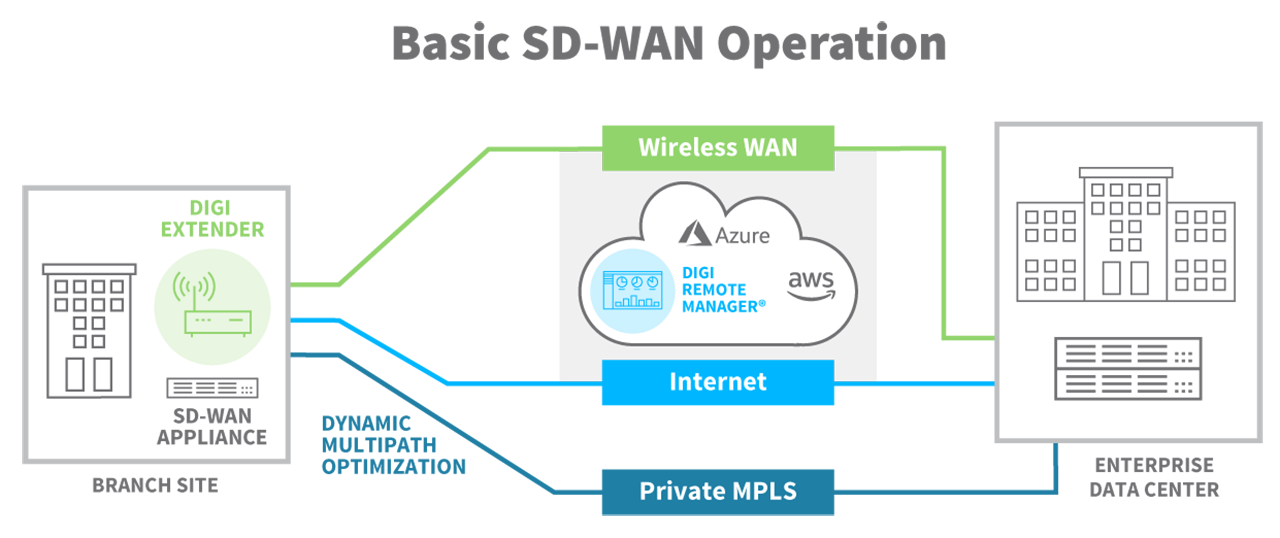SD-WAN stands for Software-Defined Wide Area Network. SD-WANs are an approach to network architecture that offers the advantages of greater control, flexibility and agility, at a lower cost, without sacrificing security. As more business applications are hosted in the cloud, organizations seeking better performance from their networks have been showing increasing interest in SD-WAN functionality. The speed, low cost and other benefits have made SD-WAN one of the fastest-growing segments in the network infrastructure market.
1
Digi supports SD-WAN in an agnostic fashion, and can integrate our cellular technology with a wide range of providers. Those seeking SD-WAN technology can therefore partner with Digi and find the right solution for their requirements, combining Digi’s robust, high-performance cellular products with the right SD-WAN vendor solution.
The main purpose of any wide-area network (WAN) is to connect business users to their applications quickly and securely. In many traditional WANs, applications are hosted in a central data center. Network traffic from branch offices, where the majority of enterprise work gets done, is then routed to the data center and back again over a private connection — even when the application is based in the cloud and accessible through the Internet. That process involves a lot of backhaul, which can therefore impact data delivery and application performance.
Smarter, More Adaptive Networking with SD-WAN

SD-WAN takes a smarter, more adaptive approach to networking. It allows application data to take a faster, cheaper route to the user, and with no loss in security. With SD-WAN, organizations can keep their private networks in place but supplement them with public network connectivity, which is readily available and usually at a significantly lower cost, because SD-WAN systems have the option of using consumer-level broadband.
SD-WAN leverages multiple transport mechanisms – including MPLS (multiprotocol label switching), wireless LTE and broadband Internet. It then uses software to intelligently monitor and route the traffic, based on the fastest, most efficient way to transmit data, as well as on the business priority and the security or privacy requirements of the data itself. SD-WAN appliances are “application aware,” so they can recognize which applications belong on the network and assign them the priority they deserve.
Zero-touch provisioning is another benefit of SD-WAN. IT teams can remotely configure hundreds of devices at a time, pushing software changes out to the network basically at will. This is not only faster, but provides more consistency and uniformity in policies and settings.
Optimized Connectivity to Empower SD-WAN

Digi solutions complement SD-WANs by providing organizations with an optimized LTE handoff to whatever SD-WAN appliance they choose to use. Again, Digi is SD-WAN vendor agnostic, so our LTE devices supplement the capabilities of the larger SD-WAN appliance by providing connectivity between the LTE network through an Ethernet cable, which then connects to the SD-WAN appliance. Additionally many of Digi’s LTE routers and cellular extenders are designed to be remotely mounted or “extended” outside of the data center to capture the best signal possible and provide enhanced LTE data performance (using a single cable using Power over Ethernet).
Separating the LTE device from the SD-WAN appliance is more flexible and cost-effective in the long run. That’s because, as new cellular technology comes out — specifically 5G — there’s no need to rip and replace the entire SD-WAN appliance. Just swap out the LTE portion of the network (for example an LTE device or module) and then get as many connections in those devices as needed for the different use cases, such as failover, out-of-band management or a secondary WAN connection.
Digi's cellular solutions integrate a sophisticated remote device management solution, Digi Remote Manager®, so that no matter how large you scale your network, it's always at your fingertips through the management interface. This enables network managers to configure, deploy, monitor and update the entire network, securely, from anywhere.
Is Your SD-WAN Ready for 5G?

The coming of 5G reinforces the benefit of using a separate LTE router within an SD-WAN implementation. Because of the high-frequency characteristics of 5G, the optimum physical placement of the wireless antenna is essential. The strategy of mounting the LTE radio remotely, where signal strength is best, is not only more functional and cost-effective, it's going to become mandatory as companies start transitioning to support 5G technologies.
Finally, it’s worthwhile to note that, from an LTE data usage standpoint, more data plans are becoming available to support increased usage without substantially increasing cost. So, although metering (i.e., the cost of data transmission) has been an inhibitor in some cases in the past, that issue is being minimized.
Digi is here to support our customers with targeted solutions to complement their wider network strategies. Digi cellular extenders are purpose-built for SD-WAN — both for the current 4G LTE and the upcoming 5G options. And wireless offers rapid deployment, especially in remote areas.
To learn about Digi 4G LTE and 5G-ready cellular routers that can enhance your own SD-WAN implementation, visit our Cellular Routers page. Or contact us for help selecting the right solution for your application.
1 Michael Cooney, “SD-WAN - What it means for enterprise networking, security, cloud computing,” Network World, Oct 9, 2019